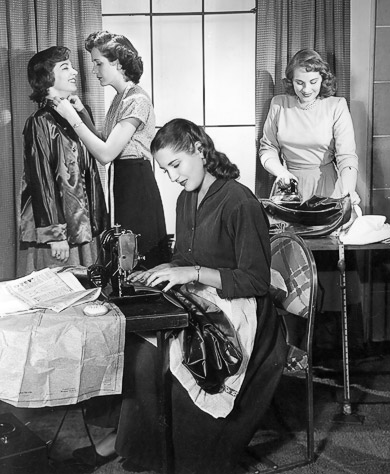A primer of the fields of fashion.
Please help us to make this a useful page. Please contribute! We’d like to create a list of jobs / titles / majors / programs that would be useful for both faculty and students planning careers. As the list becomes more complete, we will make a static page, much like our style tribes section.
When I talk about the “fashion students” at my institution, outsiders often assume they are aspiring designers — but there’s a lot more to fashion than that. My university has a program in retail but not in design; a new certificate in museum studies broadens our scope, even thought it isn’t in the same school. It can all be a little confusing, so perhaps a primer on fields of the field might help.These programs overlap and cross-pollinate, of course. Also, these stubs are intented to be simple, jargon-free summaries, not detailed explanations.
Links go out to the Occupational Outlook Handbook and other career resources.
Fashion Design is the creative endeavor to make new clothing styles. Fashion designers can work for high fashion or box stores or anywhere in between. Like any kind of designer, they must learn about the properties of the stuff they use to create, as well as considering cost, market, materials, etc.
Fashion Retail or Merchandising, then, is the business end of the bargain. Students study how to create profitable retail stores. They aspire to be buyers, marketers, or trend trackers for larger companies, or perhaps dream of their own boutique.
Relatedly, students of fashion might be training to Teach or practice Human / Family and Consumer Sciences . An understanding of fashion and consumer behavior is part of their study. Hospitality, dietetics, family studies, and teacher training are often intertwined with these programs.
All this commercial activity is at a remove from the study of Costume History. While any program with its finger in fashion may require a background in how clothing has changed over time, costume history can be its own program. People who major in costume history might become academic researchers themselves, or use that background for other work…
such as Theater Costume. In theater costume, students learn how to build garments that meet the requirements of movies, ballets, and other performing arts. Sometimes that means The Most Historically Accurate Gown…, but it often includes other criteria, such as, …That Allows the Actress to Do A Cartwheel and Will Last for Six Months of Nightly Shows. Both fashion design houses and theater companies also need skilled artistans to make patterns, cut and sew cloth, and tailor for fit.
An academic background in Costume History might also lead to Museum Studies, to become a qualified curator or conservator of a textile collection.
Two books in particular talk about jobs in fashion: The Fashion Industry and Its Careers by Michelle Granger (2015) lists dozens of other specialties. Bloomsbury’s Guide to Fashion Career Planning (2016) focuses more on job search and career strategies.
All this matters to librarians, because each program requires different resources. For example, I probably don’t need to subscribe to Passport GMID for design students. Costume historians need books showing x-rayed garments; theater costumers could use videos about how to make a flat pattern. Designers need inspiration; business people need statistics. As always, the work of the librarian follows the work of the departments with which they collaborate.
Photo credits:
Irene: Why didn’t I live in the 1940’s. http://irene.ie/archives/2496
1944: Henry Poole and Co., London. https://en.wikipedia.org/wiki/Henry_Poole_%26_Co







